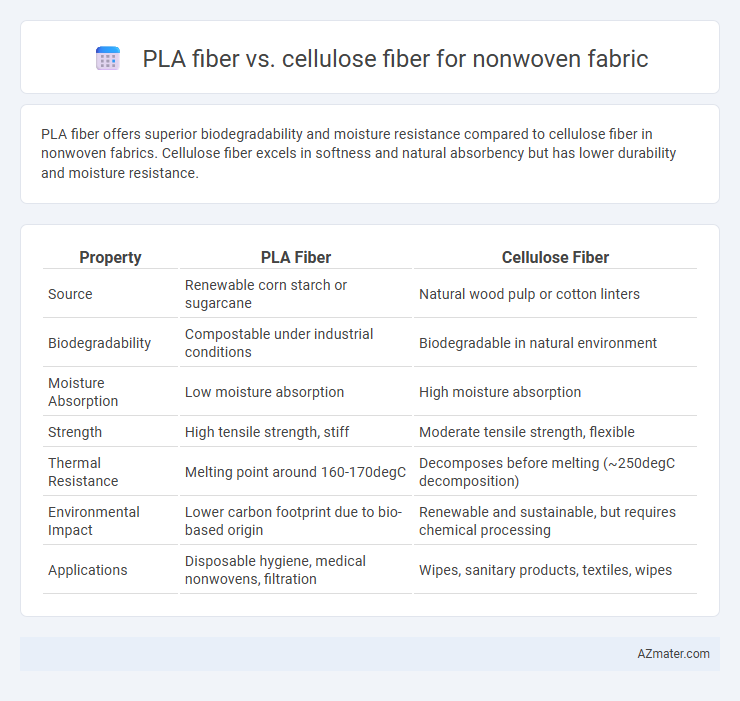PLA fiber offers superior biodegradability and moisture resistance compared to cellulose fiber in nonwoven fabrics. Cellulose fiber excels in softness and natural absorbency but has lower durability and moisture resistance.
Table of Comparison
| Property | PLA Fiber | Cellulose Fiber |
|---|---|---|
| Source | Renewable corn starch or sugarcane | Natural wood pulp or cotton linters |
| Biodegradability | Compostable under industrial conditions | Biodegradable in natural environment |
| Moisture Absorption | Low moisture absorption | High moisture absorption |
| Strength | High tensile strength, stiff | Moderate tensile strength, flexible |
| Thermal Resistance | Melting point around 160-170degC | Decomposes before melting (~250degC decomposition) |
| Environmental Impact | Lower carbon footprint due to bio-based origin | Renewable and sustainable, but requires chemical processing |
| Applications | Disposable hygiene, medical nonwovens, filtration | Wipes, sanitary products, textiles, wipes |
Introduction to PLA and Cellulose Fibers
PLA fiber, derived from renewable resources like corn starch or sugarcane, offers biodegradability and excellent moisture resistance, making it ideal for sustainable nonwoven fabrics. Cellulose fiber, extracted from plant sources such as wood pulp or cotton linters, provides natural absorbency, breathability, and biodegradability, widely used in hygiene and medical nonwovens. Both fibers contribute to eco-friendly textile solutions, with PLA offering synthetic polymer strength and cellulose fibers delivering natural fiber comfort.
Overview of Nonwoven Fabric Technology
Nonwoven fabric technology utilizes both PLA fiber and cellulose fiber to create materials with diverse properties for industrial and medical applications. PLA fiber, derived from renewable resources like corn starch, offers biodegradability and strength, making it ideal for eco-friendly nonwoven products. Cellulose fiber, sourced from wood pulp or cotton linters, provides excellent absorbency and softness, enhancing the comfort and performance of disposable hygiene and filtration nonwoven fabrics.
Raw Material Sources: PLA vs Cellulose
PLA fiber is derived from renewable resources such as corn starch or sugarcane through a fermentation process, making it a bio-based polyester with consistent quality and biodegradable properties. In contrast, cellulose fiber is sourced primarily from wood pulp, cotton linters, or other plant-based materials rich in cellulose, offering natural biodegradability and high moisture absorption. Both raw materials support sustainable production, but PLA's reliance on agricultural feedstocks differs from cellulose's extraction from lignocellulosic biomass.
Manufacturing Processes Comparison
PLA fiber production involves polymerization of lactic acid derived from renewable resources, followed by melt spinning or electrospinning to form fibers, which is energy-efficient and produces biodegradable nonwoven fabrics. Cellulose fiber manufacturing requires extracting cellulose from wood pulp or cotton linters, then chemically or mechanically processing it into fibers through viscose, lyocell, or rayon methods, often involving more chemical usage and water consumption. PLA's manufacturing process generally offers a lower environmental footprint and simpler scaling compared to the more resource-intensive and chemically complex cellulose fiber fabrication for nonwovens.
Mechanical Properties Evaluation
PLA fiber exhibits higher tensile strength and stiffness compared to cellulose fiber, making it suitable for durable nonwoven fabric applications. Cellulose fiber offers superior flexibility and elongation, contributing to enhanced tear resistance in nonwoven structures. Mechanical properties evaluation demonstrates that PLA fibers provide better load-bearing capacity, while cellulose fibers ensure improved fabric resilience and comfort.
Biodegradability and Environmental Impact
PLA fiber, derived from renewable resources like corn starch, offers excellent biodegradability with complete decomposition in industrial composting facilities typically within 12 weeks, reducing long-term environmental pollution. Cellulose fiber, sourced from plant materials such as wood pulp, is naturally biodegradable under various environmental conditions and breaks down faster than many synthetic fibers, contributing to lower ecological footprints. Both fibers provide sustainable alternatives to petrochemical-based materials, but cellulose fibers often have a lower carbon footprint due to less intensive manufacturing processes and widespread availability.
Cost Analysis and Economic Feasibility
PLA fiber generally has higher raw material and processing costs compared to cellulose fiber due to its bioplastic origin and more complex production methods, which can impact overall nonwoven fabric pricing. Cellulose fiber, derived from abundant natural sources such as wood pulp, offers lower raw material costs and established supply chains, enhancing its economic feasibility for large-scale nonwoven fabric production. The cost-benefit analysis favors cellulose fiber for applications prioritizing affordability, while PLA fiber may justify higher costs through sustainability premiums in eco-conscious markets.
Performance in Medical and Hygiene Applications
PLA fiber exhibits superior biocompatibility and biodegradability compared to cellulose fiber, making it highly suitable for medical and hygiene nonwoven fabrics. Its higher tensile strength and moisture resistance enhance barrier protection, crucial for surgical gowns and face masks. Cellulose fiber offers excellent absorbency and softness but lacks the durability and sterilization tolerance required for advanced medical applications.
Market Trends and Consumer Demand
PLA fiber and cellulose fiber are rapidly gaining traction in the nonwoven fabric market due to increasing consumer demand for sustainable and biodegradable materials. PLA fiber, derived from renewable resources like corn starch, offers excellent compostability and is favored in eco-friendly packaging and disposable hygiene products. Cellulose fiber, extracted from wood pulp, excels in softness and absorbency, driving its adoption in medical, hygiene, and wipes applications as industries shift toward greener solutions.
Future Prospects and Innovation Opportunities
PLA fiber exhibits strong potential in nonwoven fabric applications due to its biodegradability, renewability, and lower carbon footprint compared to cellulose fiber, aligning with sustainability trends in the textile industry. Innovations in PLA fiber production, such as enhanced melt-spinning techniques and bio-based composite development, are poised to improve mechanical properties and broaden functional uses, especially in medical and filtration sectors. Future prospects include integrating advanced nanotechnology and enzymatic modifications to optimize PLA fibers' performance, positioning them as viable alternatives to traditional cellulose fibers in eco-friendly nonwoven fabrics.

Infographic: PLA fiber vs Cellulose fiber for Nonwoven fabric
 azmater.com
azmater.com